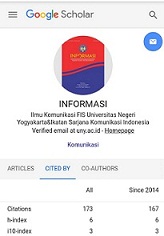INTERAKSI SIMBOLIK SANTRI PONDOK PESANTREN AL-AMIN PABUARAN PURWOKERTO
DOI:
https://doi.org/10.21831/informasi.v45i1.7767Abstract
AbstractIn this life, human need to interact with other people for accomplishing social needs. Without communication, human, can't interact. Santri (student at traditional Muslim School) also need to have interaction with others. Santri is designation for a person who lives in Islamic Boarding House and study about religiousness. This research tries to explain about santri's stigma and symbols use by santri. From this research, it can be inferred that: there are 2 Stigmas that attached in santri, they are physical stigma (it's about santri's attributes and clothes) and positive social stigma; There are numbers of symbols dealing with verbal and nonverbal communication use by santri with their team; Not all of social stigma that attached to santri's role is applied well by santri themselves. Moreover there is some santri that their manner is far from Islamic education.
Abstrak
Dalam hidup, manusia membutuhkan interaksi terhadap orang lain untuk memenuhi kebutuhan sosialnya. Tanpa komunikasi, manusia tidak dapat berinteraksi.Begitu juga dengan santri.Santri adalah sebutan bagi orang yang tinggal di pondok pesantren dan mengkaji ilmu agamaPenelitian ini juga mencoba menjelaskan mengenai stigma santri dan penggunaan simbol oleh santri. Dari penelitian ini, dapat disimpulkan bahwa: stigma yang menempel pada diri santri ada dua, yaitu stigma fisik (menyangkut pakaian dan atribut santri) dan stigma sosial yang positif; Terdapat sejumlah simbol menyangkut komunikasi verbal dan nonverbal yang digunakan oleh para santri dengan penggunaan tim mereka; Tidak semua stigma sosial yang menempel pada peran santri, dijalankan dengan baik oleh para santri. Bahkan ada beberapa santri yang perilakunya jauh dari ajaran agama Islam.
Keywords: Phenomenology, Symbolic Interaction, Santri of Islamic Boarding House
References
Moleong, Lexy J. 2007. Metodologi Penelitian Kualitatif. Edisi Revisi. Bandung: PT Remaja Rosdakarya.
Mulyana, dan Solatun. 2007. Metode Penelitian Komunikasi. Bandung: PT Remaja Rosdakarya.
Mulyana, Deddy. 2008. Metodologi Penelitian Kualitatif "Paradigma Baru Ilmu Komunikasi dan Ilmu Sosial Lainnya". Bandung: PT Remaja Rosdakarya.
Soeprapto, Riyadi. 2002. Interaksionalisme Simbolik. Malang:Averroes Press.
Downloads
Published
Issue
Section
License
Authors who publish with this journal agree to the following terms:- Authors retain copyright and grant the journal right of first publication with the work simultaneously licensed under a Creative Commons Attribution License that allows others to share the work with an acknowledgement of the work's authorship and initial publication in this journal.
- Authors are able to enter into separate, additional contractual arrangements for the non-exclusive distribution of the journal's published version of the work (e.g., post it to an institutional repository or publish it in a book), with an acknowledgement of its initial publication in this journal.
- Authors are permitted and encouraged to post their work online (e.g., in institutional repositories or on their website) prior to and during the submission process, as it can lead to productive exchanges, as well as earlier and greater citation of published work (See The Effect of Open Access).





















